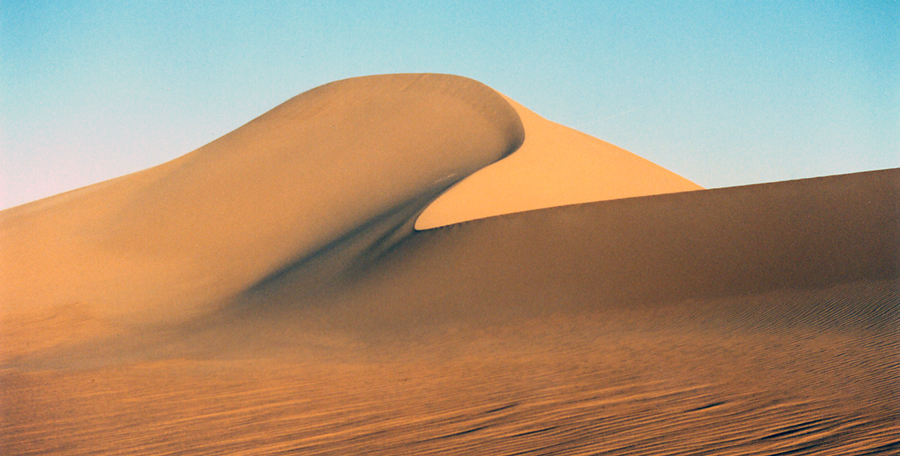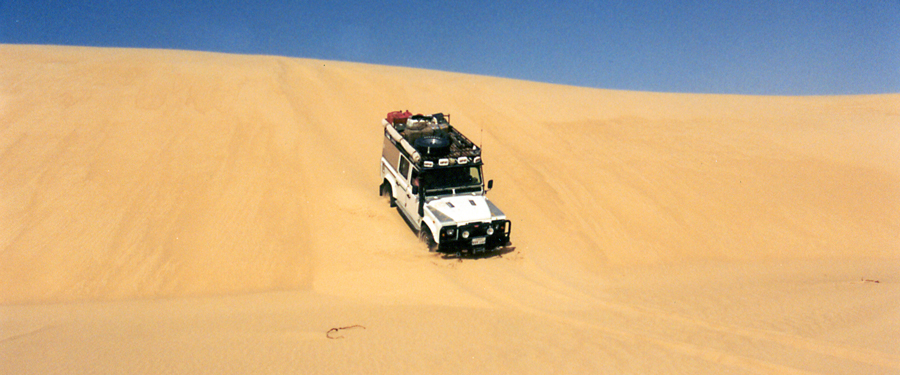maxingout
Adventurer
More than 400 years ago, a massive meteor struck and buried itself in the sand dunes of the Empty Quarter of Saudi Arabia. We decided to make an expedition to the Wabar meteor crater in our Land Rover Defenders.
Not all sand dunes are created equal, especially when you travel in the dunes of the Empty Quarter. The Empty Quarter is a massive sandbox with more than a million square miles of sand.
In the northern Empty Quarter, sandy gravel plains gradually give way to small rolling dunes which eventually evolve into isolated crescent shaped barchan dunes. Over time, these dunes coalesce and grow in height becoming progressively larger the farther south you travel. On the southern reaches of the Empty Quarter you encounter massive mountains of sand.
This article is about driving in sand for nearly eight hundred kilometers in the Empty Quarter with a specific destination in mind. We are driving to Wabar close to the center of the Empty Quarter to examine a site where a large meteor augured into the Arabian Sands.
At Wabar, an iron meteorite traveling in excess of 25,000 kilometers per hour broke into four fragments and plowed into the Arabian sands with an impact rated as a 13 kiloton explosion similar in energy to the nuclear weapon that destroyed Hiroshima in world war II. Nobody knows for sure when the meteor strike occurred, but estimates place it about 400 years ago. The largest known chunk of the iron/nickel meteorite is on display at King Saud University in Riyadh. This chunk weighs in at nearly two and a half tons.
Our expedition will drive through the Arabian sands using three vehicles giving us good redundancy just in case a vehicle breaks down in deep desert. It's highly unlikely that three vehicles would have mechanical failures on such a trip.
I have driven to the Wabar Crater three times by three different routes. The difficulty of the trip is directly related to the selected route and the season of the year. If you go in rainy season just after the rains, the trip is much easier. If you travel in June, July, or August when the desert sands have zero moisture, you are asking for an extremely difficult and arduous trip, and if you make a serious mistake, you can be dead in a few hours in the 140 degree F heat. If you travel in a shoulder season with more temperate weather, you should be fine as long as your vehicles are well equipped for deep desert exploration and survival.
To read the story of this expedition, visit: http://MaxingoutOffroad.com
Not all sand dunes are created equal, especially when you travel in the dunes of the Empty Quarter. The Empty Quarter is a massive sandbox with more than a million square miles of sand.
In the northern Empty Quarter, sandy gravel plains gradually give way to small rolling dunes which eventually evolve into isolated crescent shaped barchan dunes. Over time, these dunes coalesce and grow in height becoming progressively larger the farther south you travel. On the southern reaches of the Empty Quarter you encounter massive mountains of sand.
This article is about driving in sand for nearly eight hundred kilometers in the Empty Quarter with a specific destination in mind. We are driving to Wabar close to the center of the Empty Quarter to examine a site where a large meteor augured into the Arabian Sands.
At Wabar, an iron meteorite traveling in excess of 25,000 kilometers per hour broke into four fragments and plowed into the Arabian sands with an impact rated as a 13 kiloton explosion similar in energy to the nuclear weapon that destroyed Hiroshima in world war II. Nobody knows for sure when the meteor strike occurred, but estimates place it about 400 years ago. The largest known chunk of the iron/nickel meteorite is on display at King Saud University in Riyadh. This chunk weighs in at nearly two and a half tons.
Our expedition will drive through the Arabian sands using three vehicles giving us good redundancy just in case a vehicle breaks down in deep desert. It's highly unlikely that three vehicles would have mechanical failures on such a trip.
I have driven to the Wabar Crater three times by three different routes. The difficulty of the trip is directly related to the selected route and the season of the year. If you go in rainy season just after the rains, the trip is much easier. If you travel in June, July, or August when the desert sands have zero moisture, you are asking for an extremely difficult and arduous trip, and if you make a serious mistake, you can be dead in a few hours in the 140 degree F heat. If you travel in a shoulder season with more temperate weather, you should be fine as long as your vehicles are well equipped for deep desert exploration and survival.
To read the story of this expedition, visit: http://MaxingoutOffroad.com
Attachments
Last edited:



